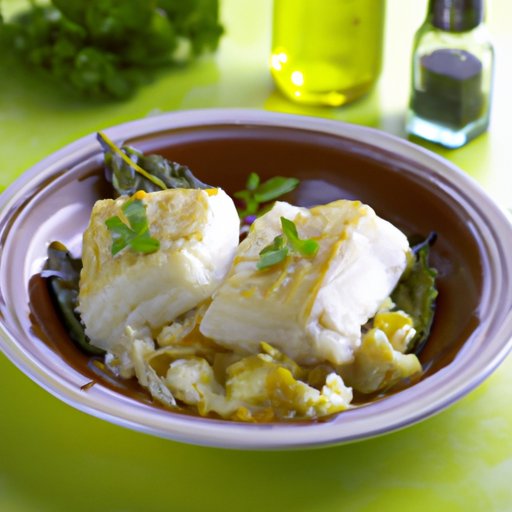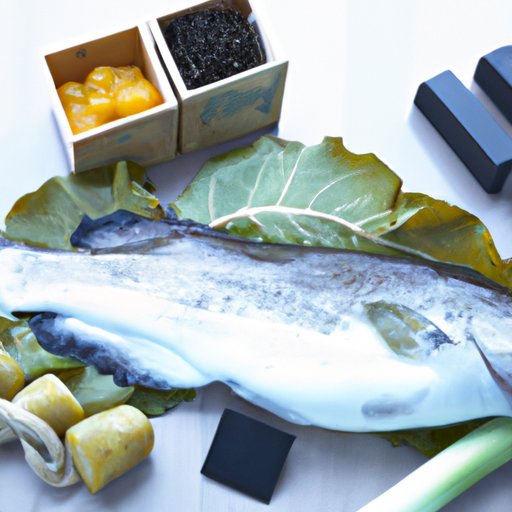Introduction
Cod is one of the most widely consumed types of fish in the world. It is a popular source of lean protein and healthy fats, and is often recommended as part of a balanced diet. But despite its popularity, there are still some questions about the sustainability and health risks associated with eating cod. This article will explore these issues in detail, providing an in-depth look at the nutritional value, environmental impact, and health benefits and risks of eating cod.

A Nutritional Analysis of Cod
Cod is a good source of several essential nutrients, including protein, vitamins, and minerals. A 3-ounce (85-gram) serving contains approximately 17 grams of protein and 1.5 grams of fat. It is also a rich source of omega-3 fatty acids, which are known for their anti-inflammatory properties. Additionally, cod is a good source of several B vitamins, such as thiamine, riboflavin, niacin, and vitamin B6. It is also high in several minerals, including phosphorus, selenium, zinc, and iron.
Exploring the Environmental Impact of Eating Cod
Cod is one of the world’s most popular seafoods, but its popularity has come at a cost to the environment. Overfishing is a major problem, as fishermen have been targeting cod for centuries. This has caused a dramatic decrease in cod populations in many parts of the world. Additionally, overfishing has led to the destruction of other marine species, as trawlers often catch large amounts of bycatch, or non-targeted species, when fishing for cod.
In recent years, aquaculture has become increasingly popular as a way to reduce the environmental impact of cod harvesting. Aquaculture is the practice of raising fish in controlled environments, such as tanks or ponds, rather than wild sources. This method can be beneficial because it reduces the pressure on wild cod populations, while still providing a reliable source of cod. However, some concerns have been raised about the potential environmental impacts of aquaculture, such as water pollution and the spread of disease.
Health Benefits of Eating Cod
In addition to its environmental benefits, cod is also a nutritious food that can provide a number of health benefits. Studies have shown that consuming cod can help improve heart health, reduce inflammation, and even boost brain function. The omega-3 fatty acids found in cod are thought to be responsible for many of these benefits. Omega-3s are vital for maintaining cell structure and function, and are particularly important for heart and brain health.
Cod is also a good source of vitamin A, which is important for eye health. Vitamin A helps protect against age-related vision problems, such as macular degeneration. Additionally, cod is a good source of selenium, which is an essential mineral for overall health. Selenium helps support the immune system and can even help protect against cancer.
Is Cod a Sustainable Choice?
When choosing seafood, it is important to consider the sustainability of the source. Fortunately, there are several organizations that certify sustainable fisheries, including the Marine Stewardship Council (MSC) and the Seafood Watch Program. These organizations evaluate fisheries based on several criteria, including responsible fishing practices, population health, and environmental impact. When buying cod, look for products that have been certified by one of these organizations.
Examining the Pros and Cons of Eating Cod
As with any food, there are both pros and cons to consider when deciding whether or not to eat cod. On the plus side, cod is a nutritious source of protein and healthy fats, and it can provide a number of health benefits. It can also be a sustainable choice if purchased from a certified fishery. On the downside, cod may contain contaminants, such as mercury and PCBs, which can pose health risks.

Cooking with Cod: Healthy Recipes
Cod is a versatile fish that can be prepared in a variety of ways. Here are three healthy recipes that highlight the flavor and nutrition of cod:
- Baked Cod with Olive Oil and Herbs: Preheat oven to 375°F (190°C). Place cod fillets in a baking dish. Drizzle with olive oil, then season with salt, pepper, and fresh herbs. Bake for 10–15 minutes, or until cod is cooked through. Serve with a side of roasted vegetables.
- Grilled Cod with Lemon and Garlic: Preheat grill to medium-high heat. Brush cod fillets with olive oil and season with salt, pepper, garlic, and lemon juice. Grill for 5–7 minutes per side, or until cod is cooked through. Serve with a side of grilled vegetables.
- Cod Cakes with Brown Rice and Spinach: Preheat oven to 350°F (175°C). Combine cooked cod, cooked brown rice, spinach, egg, and seasonings in a bowl. Form into small patties and place on a greased baking sheet. Bake for 15–20 minutes, or until golden brown. Serve with a side of steamed vegetables.

Exploring the Health Risks of Eating Cod
Although cod can be a nutritious and sustainable choice, there are some potential health risks associated with eating it. One concern is mercury contamination. Mercury is a naturally occurring element that can accumulate in the bodies of predatory fish, such as cod. In high doses, mercury can cause neurological and developmental problems. Additionally, cod may contain traces of pollutants, such as polychlorinated biphenyls (PCBs), which can also pose health risks.
Finally, cod can be a potential allergen for some people. Symptoms of a cod allergy can include hives, itching, swelling, nausea, and difficulty breathing. If you experience any of these symptoms after eating cod, it is important to seek medical attention.
Conclusion
Cod is an important source of protein and omega-3 fatty acids, but it also carries potential health risks. It is important to consider the nutritional value, environmental impact, and potential health benefits and risks of eating cod before making a decision. When purchasing cod, look for products that have been certified by organizations like the Marine Stewardship Council and Seafood Watch Program.
(Note: Is this article not meeting your expectations? Do you have knowledge or insights to share? Unlock new opportunities and expand your reach by joining our authors team. Click Registration to join us and share your expertise with our readers.)
